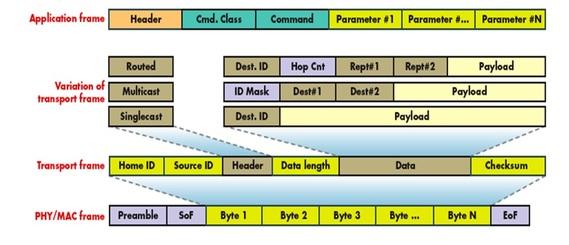Z-Wave Protocol Stack: Layer Breakdown and Functionality
Advertisement
This document provides an overview of the Z-Wave protocol stack, detailing its layers and their functions. The Z-Wave protocol is designed for short message communication (a few bytes) between a control unit and Z-Wave nodes. It’s a low-bandwidth, half-duplex protocol focused on reliable wireless communication. It doesn’t handle large data volumes, time-critical data, or streaming.
As depicted in Figure 1, the Z-Wave protocol stack consists of five layers: Physical (PHY), Media Access Control (MAC), Transport, Network, and Application. Security is not defined in the open Z-Wave specifications and is therefore implementation-specific.
The main functions of each layer are outlined below:
-
Physical (PHY) Layer: Handles modulation, RF channel assignment, preamble addition (at the transmitter), and preamble-based synchronization (at the receiver).
-
MAC Layer: Manages HomeID and NodeID, and controls medium access using collision avoidance and backoff algorithms.
-
Transport Layer: Manages frame transmission/reception, retransmissions, ACK frame transmission, and checksum insertion.
-
Network Layer: Deals with frame routing, topology scanning, and routing table updates.
-
Application Layer: Manages control of payloads within transmitted and received frames.

Figure 2 illustrates the fields within various protocol layers of the Z-Wave stack, showing the PHY/MAC frame, transport layer frames, and application layer frames.

Before delving deeper, you may find it helpful to review the basics of Z-Wave networking.
Z-Wave Physical Layer (PHY)
The physical layer handles modulation, coding, and the insertion of a known bit pattern (the “preamble”) for receiver synchronization. It also manages RF channel allocation. Key configuration parameters for the PHY include the data rate (9.6, 40, or 100 Kbps).
Z-Wave MAC Layer
The MAC layer controls medium access among slave nodes, using collision avoidance and backoff algorithms. It manages network operation based on HomeID, NodeID, and other parameters within the Z-Wave frame.
Z-Wave Transport Layer
The transport layer is responsible for retransmissions, packet acknowledgments, waking up low-power nodes, and authenticating packet origins. It utilizes four basic frame types for transferring commands:
Transport Frame Format: { HomeID, Source NodeID, Header, length, Data byte(0 to X), Checksum }
The four transport layer frame types are:
-
Singlecast Frame: Transmitted to a specific Z-Wave node. The receiver acknowledges the frame, informing the transmitter of successful receipt. If the frame or its ACK is lost or damaged, the singlecast frame is retransmitted.
-
ACK Frame: A singlecast frame without a data payload, used for acknowledgments.
-
Multicast Frame: Transmitted to multiple nodes (up to 232). Acknowledgments are not supported, so this type is not used for reliable communication.
-
Broadcast Frame: Received by all nodes in the network and not acknowledged by any nodes.
Z-Wave Network Layer

The network layer controls frame routing between nodes. Both controllers and slave nodes participate in routing.
The responsibilities of the network layer include:
- Transmission of frames with a correct repeater list.
- Scanning of network topology.
- Maintenance of the routing table in the controller.
The routing layer uses two frame types:
-
Routed Singlecast Frame: A one-node destination frame with acknowledgment, containing repeater information. The frame is repeated from one repeater to another until it reaches the destination.
-
Routed Acknowledge Frame: A routed singlecast frame without a payload, confirming that the routed singlecast frame has reached its destination.
Z-Wave Routing Table
Controllers maintain a routing table containing information about all nodes in the network. This is a bit field table, as shown below:
| 1 | 2 | 3 | 4 | 5 | 6 | |
|---|---|---|---|---|---|---|
| 1 | 0 | 1 | 1 | 0 | 0 | 0 |
| 2 | 1 | 0 | 0 | 0 | 1 | 0 |
| 3 | 1 | 1 | 0 | 0 | 0 | 0 |
| 4 | 0 | 0 | 0 | 0 | 1 | 0 |
| 5 | 0 | 1 | 0 | 1 | 0 | 0 |
| 6 | 0 | 0 | 0 | 0 | 0 | 0 |
Table-1: Z-Wave Routing Table
The primary controller builds this routing table based on information received from all nodes in the Z-Wave network.
Z-Wave Application Layer
The application layer decodes and executes commands within the Z-Wave network.
Frame Format: { Single/Multi, broadcast frame header, Application command class, Application command, Command parameter1-to-X }
The Application command class defines the command category:
00h-1Fh: Reserved for Z-Wave protocol commands.20h-FFh: Reserved for Z-Wave application commands.
All Z-Wave frame types, except the ACK frame, contain an application command.
Advertisement
 RF
RF

